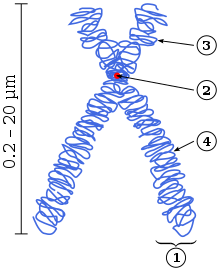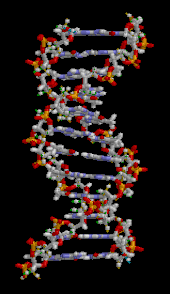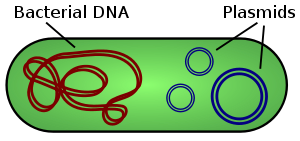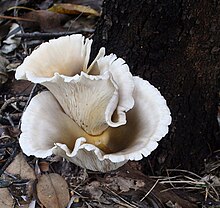Chromosomes are the thread like formations that are seen in the inner cells of both plant and animals. A Plasmid DNA is extra chromosomal DNA that is distinct from the genomic DNA.
Plasmids and said to be different from the chromosomal DNA and thus the question for is a chromosome a plasmid is not true. These both also tend to replication independently with having small genes in its number and are much linked with the antibiotic resistance and thus can be passed from one of the cell to other.
The DNA plasmid refers to any circular small DNA stranded molecule that is much is distinct from the cell having the chromosomal DNA while the chromosomes refers to the molecule that tends to have genetic data in all the forms of life and thus the question for is a chromosome a plasmid is not true. Thus it is said to be the basic difference between the chromosomal and plasmid DNA.

The very main function of the chromosome is to get the DNA transferred by carrying the genetic data from the parents to the offspring. The chromosomes shall play a good role at the time of cell division and thus also protects the DNA from getting harmed while the plasmid carries the genes that are antibiotic resistant and also spreads to the entire human body and thus the question for is a chromosome a plasmid is not true.
What is allele with example?
Alleles are said to be the pairs being multiple in its from and shall be linked to affect the specific trait in the offering while transfer. The term allele denotes the variant of a given gene. In genetics it is normal for genes to show deviations or diversity
The term locus is the place where the gene is seen on the chromosome. A pair of the alleles tend to find out the same trait for like that of the eye color, hair pattern while one allele coding for black and the other one coding from brown and thus the question for is a chromosome a plasmid is not true.
All of the alleles that are seen make up to the genotype in the organism with always seen in pair form. This genotype is called the homozygous with also being differ in form called the heterozygous. There is also a dominate pair of allele seen that tend to overrule the character of the submissive allele in the genotype. A dominant always overrules with in some place neither being so.

An allele is one of a pair of genes that appear at a particular location on a particular chromosome and control the same characteristic, such as blood type or color blindness. Alleles are also called alleleomorphs thus the question for is a chromosome a plasmid is not true.
Where are chromosomes found in cell?
Chromosomes are found in the nucleus of every cell of our body and are made up of DNA, tightly coiled around proteins. We have 23 pairs of chromosomes altogether, and they can only be easily observed during cell division.
Chromosomes are found inside the nucleus of animal and plant cells. Each chromosome is made of proteins normally the histones and non-histones and a single molecule of deoxyribonucleic acid thus the question for is a chromosome a plasmid is not true. The function of chromosomes is to carry the genetic material from one generation to another.
The cell nucleus contains all of the cell’s genome, except for the small amount of mitochondrial DNA and, in plant cells, plastid DNA. Nuclear DNA is organized as multiple long linear molecules in a complex with a large variety of proteins, such as histones, to form chromosomes. The genes within these chromosomes are structured in such a way to promote cell function.

The nucleus maintains the integrity of genes and controls the activities of the cell by regulating gene expression—the nucleus is, therefore, the control center of the cell. Eukaryotes usually have a single nucleus, but a few cell types, such as mammalian red blood cells, have no nuclei, and a few others including osteoclasts have many. Because the nuclear envelope is impermeable to large molecules, nuclear pores are required to regulate nuclear transport of molecules across the envelope.
Is allele and chromosome the same?
Alleles are termed to be the variation in gene that are seen in the place of the chromosome while chromosome are threads packed up tight and thus the question for is a chromosome a plasmid is not true.
Each of the gene has a specific locus or location on the chromosome in 2 of the copies staying independent of each other and one copy of the gene is taken from each of the parent and thus both these terms are not same with one being related to other for its function and thus the question for is a chromosome a plasmid is not true.
There are many genes that have different variety and are located in the same place or at a same genetic locus on the chromosome and thus the question for is a chromosome a plasmid is not true. Thus for this fact, humans are said to be the diploid ones while having 2 of the alleles at each of the genetic locus and also attached to one of the allele linked from each of the parent.
Both of the DNA and the plasmids tend to be seen in the cells of bacteria. Both of them do have genes and are made up of DNA. They are also vital on its own terms with plasmids having genes that are not needed for the growth of the cell and its replication as well and thus the question for is a chromosome a plasmid is not true. A gene is a unit of hereditary information.
How are plasmids and chromosomes similar?
Chromosome are said to be the largest variations and also tend to be vital for the genetic data for all of the living beings in basic form. Allele, also called allelomorph, any one of two or more genes that may occur alternatively at a given site
Plasmid are mostly said to be small that has only genes in addition to that which are useful in many other ways and also conditions. Thus for this terms plasmids and chromosomes shows no similarity in any field and thus the question for is a chromosome a plasmid is not true.
The chromosomal DNA replicate via the genome and the plasmid DNA has the replication site and thus is also called to be self-replicative on natural basis. The chromosomal DNA is important for proper cell to work and then reproduce but the plasmid is not vital for this use and thus the question for is a chromosome a plasmid is not true.

The DNA of the plasmid is part of the DNA that is extra in its chromosomal composition and is thus separated from the genetic DNA. It also occurs in the cells of the prokaryotes and is thus circular in its nature and thus the question for is a chromosome a plasmid is not true. The plasmids tend to have genes that are not vital and also considered not so useful for the cell replication and cell to grow and is located in a region of the bacterial cytoplasm visible when viewed with an electron microscope.
Where are plasmid located?
A plasmid is a small circular DNA molecule found in bacteria and some other microscopic organisms. Plasmids are physically separate from chromosomal DNA and replicate independently.
Plasmids are mainly found in bacteria, but they can also be found in archaea and multicellular organisms. Plasmids usually carry at least one gene, and many of the genes that plasmids carry are beneficial to their host organisms. These plasmids can exist in two forms, which are extrachromosomal replicons or integrated plasmids. These plasmids are known as episomes.
The mitochondria within human cells also contains a closed circular DNA molecule; this is known as mtDNA. It encodes 37 genes and 16500bp. It also occurs in the cells of the prokaryotes and is thus circular in its nature and thus the question for is a chromosome a plasmid is not true. Plasmids naturally exist in bacterial cells, and they also occur in some eukaryotes. The bacterial genome is composed of a single molecule of chromosomal
Often, the genes carried in plasmids provide bacteria with genetic advantages, such as antibiotic resistance. The chromosome, along with several proteins and RNA molecules, forms an irregularly shaped structure called the nucleoid. This sits in the cytoplasm of the bacterial cell. In addition to the chromosome, bacteria often contain plasmids. They are seen in that are found in many microorganisms in the domains bacteria, archaea, and eukaryotic.
How Does Adenine Play a Role in DNA Replication?
Adenine in dna replication is crucial as it is one of the four nitrogenous bases found in DNA. During replication, adenine pairs with thymine, forming a base pair that connects the two DNA strands. This pairing ensures that genetic information is accurately copied and distributed to new DNA molecules. Adenine’s role in DNA replication contributes to the maintenance and transmission of genetic material in all living organisms.
Differences between a chromosome and a plasmid
They are not dependent on the genomic DNA and are skilled of replication by self. Also, the Plasmid DNA codes for genes that give consequences that are not required for the activity of the cell, like metal resistance, fixation of the nitrogen, resistance to the antibiotic.
| Chromosome | Plasmid |
| Tends to carry the genetic data in the cell format | Circular and also double stranded DNA is different from chromosome. |
| They are bigger in size compared to the plasmid DNA | Smaller in size on compared to chromosome DNA |
| It is the of the genomic DNA type | A form of the extrachromosomal DNA |
| Seen in both the prokaryotes and the eukaryotes | Observed only in the prokaryotes and thus the question for is a chromosome a plasmid is not true |
| Carried on by division of the cell | Carried on by the horizontal transfer of gene |
The very basic and vital difference lies in the fact that in the plasmid DNA and the chromosomal ones tend to have only 1 gene that is an add on and not useful with it not being much vital for the orgasm to live while the chromosomal one is having all of the needful data that is needed for the cell to live, replicate, grow inside the organism.
There are mostly 2 types of DNA that is seen and thus the chromosomal and the plasmid DNA are two of its kind making both sniffer and thus the question for is a chromosome a plasmid is not true. On the other part, the plasmid DNA is the type of the extrachromosomal ones that is not the genomic DNA type with only being able to consider the chromate as the genetic one. Plasmid transfection into mammalian cells is fairly straightforward.
Do bacteria have both plasmids and chromosomes?
Bacteria has only single chromosome that is seen in the cytoplasm and is seen in the nucleoid and thus the question for is a chromosome a plasmid is not true.
Bacteria is also seen as the smaller version of the DNA molecules and this is called plasmids. Thus in most cases they have both. Many of the bacteria are said to have bits of loops of the DNA and this is plasmids and is does exit and tend to replicated in the independent manner of the chromosome. These can be fungi or the yeast.
A plasmid is lastly said to be small and thus also is seen in the bacteria with also being observable in many of the microbes. The plasmids are mostly physical and also separate from the chromosomal DNA and thus also replicates in independent form and thus the question for is a chromosome a plasmid is not true. Plasmid mostly tend to be separated from the chromosomes.

The bacteria chromosome is seen in the nucleoid that is distinct in the structure of the cytoplasm and thus this double stranded double helical form is seen coated with the proteins that are called as histones. Most of the bacteria tend to appear in having a single large size chromosome that is not much universal and thus the question for is a chromosome a plasmid is not true incorporate the genetic material directly into the genome to form a stable transfection.
Conclusion
The 2 terms of plasmid and chromosome are not same term with plasmid being a much smaller version of itself seen mostly in the prokaryotes like bacteria and archaea while chromosome contains the DNA with being able to transfer it via generation and thus the question for is a chromosome a plasmid is not true.
Also Read:
- Hypertonic vs hypotonic
- Moon jellyfish characteristics
- Do proteins contain hydrogen
- Chemiosmosis in chloroplasts
- Inhibitor enzyme example
- When does the cytoplasm divide
- Gravitropism plant example
- Uracil in dna replication
- When does cell division occur
- Animal cell function
I am Ankita Chattopadhyay from Kharagpur. I have completed my B. Tech in Biotechnology from Amity University Kolkata. I am a Subject Matter Expert in Biotechnology. I have been keen in writing articles and also interested in Literature with having my writing published in a Biotech website and a book respectively. Along with these, I am also a Hodophile, a Cinephile and a foodie.
